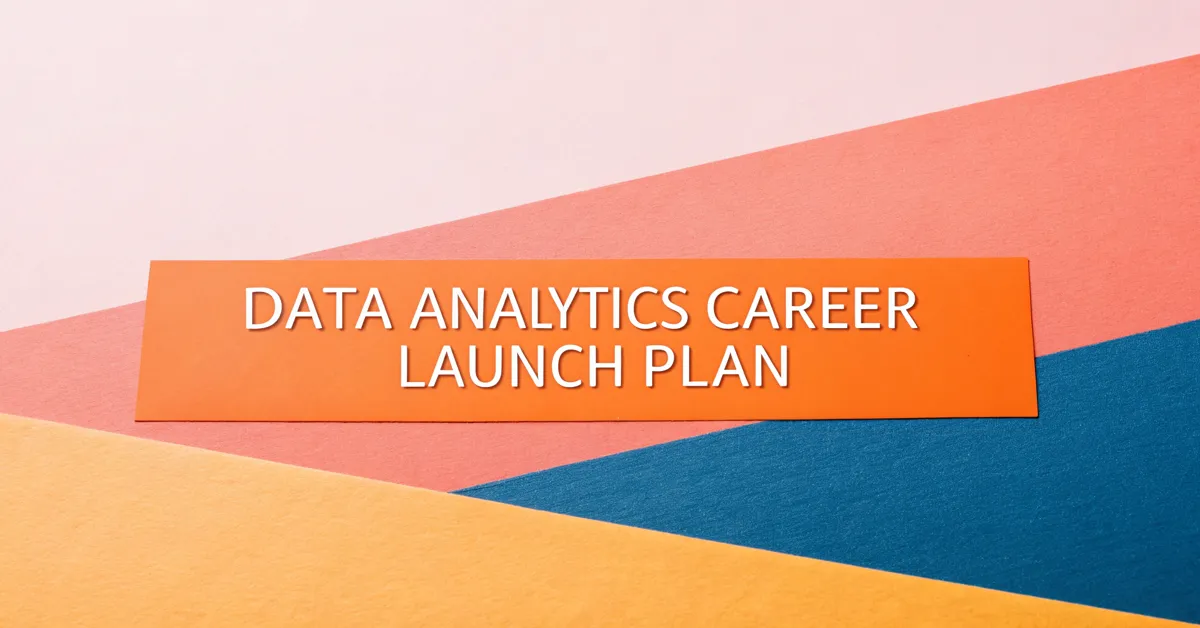Landing your dream job in data analytics can feel like scaling Mount Everest. It’s a tough climb, but with the right plan and the proper tools, you can reach the summit. The world is awash in data, and businesses are desperate for sharp minds that can turn raw information into real insights. Are you ready to take advantage of this unprecedented demand?
This article serves as your comprehensive guide to charting a data analytics career launch plan. We’ll break down the essential steps, from acquiring the right skills to crafting a killer resume, and everything in between. You will not only learn what you need to do, but how to do it, with practical advice and actionable tips.
Define Your Data Analytics Path
The field of data analytics is vast. It’s not just about churning numbers; there are many distinct roles, each with its own focus. Before you dive in, it’s a good idea to know what niche interests you. Knowing what excites you ensures your steps will have a clear direction.
Data Analyst
The data analyst is a generalist, a master of many skills. They work closely with business stakeholders to identify needs, then gather, clean, and analyze data to answer those questions. Their work involves data visualization, reporting, and communication of findings.
Business Intelligence Analyst
The business intelligence (BI) analyst focuses on past and present data, with an eye toward improving business performance. They use data to identify trends, create dashboards, and help make data-driven decisions. They often use Business Intelligence tools.
Data Scientist
The data scientist goes beyond basic analysis, using advanced statistical methods, machine learning, and predictive modeling to solve complex problems. They create algorithms, and test hypotheses. They are focused on looking towards the future, and use the past to make predictions.
Marketing Analyst
The marketing analyst specializes in marketing data. They analyze campaign performance, customer behavior, and market trends to improve marketing strategies. They use a mix of data analysis techniques with marketing principles.
Financial Analyst
The financial analyst focuses on financial data, providing insights on investments, budgeting, and financial forecasting. They assess financial risks, and use their analysis to help guide financial decisions.
Understanding the path you want to take will help you focus your learning and your job search. Now how do you get the skills you need?
Acquire Essential Data Analytics Skills
Data analytics requires a mix of technical skills and soft skills. Don’t worry if you don’t have them all yet; the most important thing is to start learning.
Technical Skills
These skills are the bedrock of data analytics.
- SQL: This is the language for database management. It’s vital for extracting and manipulating data. You’ll use SQL daily to query databases and retrieve the information you need.
- Excel: While often overlooked, Excel remains a powerful tool for data manipulation, analysis, and visualization. It’s a great place to start before moving to more complex tools.
- Programming Languages (Python or R): Python and R are the languages of choice for data analysis. Python is general purpose, and is useful for a wide range of tasks. R is focused on statistical computing.
- Data Visualization Tools (Tableau or Power BI): These tools allow you to create compelling visualizations to communicate your insights. Choose one and become proficient in it.
- Statistics: A solid understanding of statistics is crucial for interpreting data correctly and drawing meaningful conclusions.
Soft Skills
These are the skills that allow you to communicate your findings.
- Communication: You must be able to explain complex data insights to both technical and non-technical audiences.
- Problem-Solving: Data analytics is all about solving problems. You need to be able to approach problems logically and creatively.
- Critical Thinking: You need to be able to analyze information critically, identify assumptions, and evaluate the validity of your findings.
- Business Acumen: Understanding the business context is important for ensuring your analysis is relevant and actionable.
Free Online Courses
Luckily, you don’t need to spend a fortune to gain these skills. Here are some excellent free resources:
- SQL:
- Khan Academy’s SQL course (https://www.khanacademy.org/computing/computer-programming/sql)
- SQLZoo (http://sqlzoo.net/)
- Excel:
- GCFLearnFree.org’s Excel 2016 tutorial (https://edu.gcfglobal.org/en/excel2016/)
- Microsoft’s Excel training (https://support.microsoft.com/en-us/excel)
- Python:
- Codecademy’s Learn Python 3 course (https://www.codecademy.com/learn/learn-python-3)
- Google’s Python Class (https://developers.google.com/edu/python)
- R:
- DataCamp’s Introduction to R (https://www.datacamp.com/courses/free-introduction-to-r)
- R-Studio’s Learn R (https://www.rstudio.com/learn/)
- Tableau:
- Tableau Public Training Videos (https://www.tableau.com/learn/training)
- Tableau’s Free Training Videos (https://www.tableau.com/en-gb/resource/free-training-videos)
- Power BI:
- Microsoft’s Power BI learning paths (https://learn.microsoft.com/en-us/training/powerplatform/power-bi)
- edX’s Analyzing and Visualizing Data with Power BI (https://www.edx.org/course/analyzing-and-visualizing-data-with-power-bi)
- Statistics:
- Khan Academy’s Statistics and probability (https://www.khanacademy.org/math/statistics-probability)
- edX’s Statistics and Data Science MicroMasters Program (https://www.edx.org/micromasters/mitx-statistics-and-data-science)
Paid Online Courses
If you’re willing to invest a bit, these paid courses offer more structured learning and often include certifications:
- Coursera: Offers a wide range of data analytics courses and specializations from top universities and institutions.
- Udemy: Provides affordable courses on various data analytics topics, often with lifetime access.
- DataCamp: Focuses specifically on data science and analytics, with interactive coding exercises.
- edX: Partners with universities to offer certificate programs and degrees in data science.
Bootcamps
Data analytics bootcamps offer intensive, accelerated learning programs designed to get you job-ready in a short amount of time. They can be expensive, but they can be well worth it.
Certifications
Earning relevant certifications can significantly boost your resume:
- Microsoft Certified: Data Analyst Associate: Validates your skills in using Power BI to analyze data and create visualizations.
- Tableau Desktop Certified Associate: Demonstrates your proficiency in using Tableau to explore and communicate data insights.
- Cloudera Certified Data Analyst: Verifies your ability to extract, load, transform, and analyze data using SQL.
- Google Data Analytics Professional Certificate: It is offered on Coursera, and validates skills and techniques used for data analysis.
Build a Portfolio of Data Analytics Projects
Potential employers care about seeing what you can do, not just what you’ve learned. Building a portfolio of projects is the key to demonstrating your skills.
Start with Small Projects
Begin with simple projects to build confidence and gain experience.
- Analyze a public dataset: Find a dataset on Kaggle or another public repository and use it to answer interesting questions.
- Create a dashboard: Use Tableau or Power BI to create an interactive dashboard visualizing data from a spreadsheet.
- Automate a task: Write a Python script to automate a repetitive task, such as cleaning and transforming data.
Tackle More Complex Projects
Once you’re comfortable with the basics, move on to more challenging projects.
- Build a predictive model: Use machine learning techniques to build a model that predicts customer churn or sales forecasts.
- Analyze social media data: Use Python to scrape and analyze data from social media platforms to identify trends and sentiment.
- Create an A/B testing analysis: Design and analyze an A/B test to optimize a website or marketing campaign.
Showcase Your Work
Make your portfolio accessible and easy to navigate.
- GitHub: Use GitHub to store your code and documentation.
- Tableau Public or Power BI Online: Publish your dashboards online so potential employers can interact with them.
- Personal Website: Create a simple website to showcase your projects, resume, and contact information.
Examples of Portfolio Projects
These ideas can help you get started:
- Customer Segmentation Analysis: Analyze customer data to identify distinct customer segments and tailor marketing strategies.
- Sales Forecasting Model: Build a model to predict future sales based on historical data and market trends.
- Website Traffic Analysis: Analyze website traffic data to identify areas for improvement and optimize user experience.
- Sentiment Analysis of Product Reviews: Analyze product reviews to identify customer sentiment and improve product offerings.
- A/B Testing Analysis: Design and analyze A/B tests to optimize website elements and improve conversion rates.
Craft a Winning Data Analytics Resume
Your resume is your first impression. Make it count.
Highlight Relevant Skills
Emphasize the skills that are most relevant to the data analytics roles you’re targeting.
- Technical Skills: List all the tools and technologies you’re proficient in, such as SQL, Python, R, Tableau, and Power BI.
- Analytical Skills: Showcase your ability to analyze data, solve problems, and draw meaningful conclusions.
- Soft Skills: Highlight your communication, teamwork, and problem-solving skills.
Showcase Your Projects
Don’t just list your projects; describe them in detail and quantify your achievements.
- Project Description: Briefly describe the project’s objective and your role.
- Tools and Technologies: List the tools and technologies you used.
- Results: Quantify the results of your project, such as improved accuracy, increased efficiency, or cost savings.
Tailor Your Resume
Customize your resume for each job you apply for, highlighting the skills and experiences that are most relevant to the specific role.
- Review the Job Description: Carefully review the job description to identify the key skills and requirements.
- Match Your Resume: Tailor your resume to match the language and keywords used in the job description.
- Highlight Relevant Experiences: Emphasize the experiences and projects that are most relevant to the specific role.
Use Action Verbs
Start each bullet point with a strong action verb to make your resume more engaging and impactful.
- Analyzed: Data to identify trends and patterns.
- Developed: Models to predict customer behavior.
- Implemented: Solutions to improve efficiency.
- Communicated: Insights to stakeholders.
- Collaborated: With team members to achieve goals.
Optimize for ATS
Many companies use Applicant Tracking Systems (ATS) to screen resumes. Optimize your resume to ensure it gets past the ATS and into the hands of a human.
- Use Keywords: Incorporate keywords from the job description into your resume.
- Use a Simple Format: Avoid using complex formatting, such as tables and images, that can confuse the ATS.
- Submit in the Correct Format: Submit your resume in the format specified in the job posting, such as .doc or .pdf.
Resume Example Snippets
These examples illustrate how to present your skills and experiences effectively:
- Skills Section:
- Programming Languages: Python (Pandas, NumPy, Scikit-learn), R
- Data Visualization: Tableau, Power BI
- Database Management: SQL, MySQL
- Statistical Analysis: Hypothesis testing, Regression analysis
- Project Description:
- Customer Churn Prediction: Developed a machine learning model using Python and Scikit-learn to predict customer churn, resulting in a 15% reduction in churn rate.
- Sales Forecasting Dashboard: Created an interactive dashboard using Tableau to visualize sales data and forecast future sales, enabling better resource allocation.
- Website Traffic Analysis: Analyzed website traffic data using Google Analytics and SQL to identify areas for improvement, resulting in a 20% increase in website traffic.
Network and Build Connections
Networking is essential for finding job opportunities and building relationships in the data analytics community.
Attend Industry Events
Conferences, meetups, and workshops are great places to meet other data professionals and learn about new trends.
- Data Council: A community-driven conference series for data scientists and engineers.
- ODSC (Open Data Science Conference): A conference focused on open source data science.
- Strata Data Conference: A conference covering a wide range of data topics, from big data to machine learning.
- Local Meetups: Search for local data analytics meetups on Meetup.com.
Join Online Communities
Online forums and communities are great places to ask questions, share your work, and connect with other data professionals.
- Kaggle: A platform for data science competitions and community discussion.
- Reddit: Subreddits such as r/datascience, r/dataanalysis, and r/bigdata are active communities for data professionals.
- LinkedIn Groups: Join LinkedIn groups related to data analytics to connect with other professionals and share your work.
Reach Out to Professionals
Don’t be afraid to reach out to data professionals in your network or at companies you’re interested in.
- LinkedIn: Use LinkedIn to find data professionals and send them personalized connection requests.
- Informational Interviews: Ask for informational interviews to learn about their career paths and get advice on your job search.
- Follow Up: Always follow up with a thank-you note after meeting someone or having an informational interview.
Networking Example Snippets
These examples can help you reach out and connect with other data professionals:
- LinkedIn Connection Request:
- “Hi [Name], I came across your profile and was impressed by your work at [Company]. I’m also interested in data analytics and would love to connect.”
- Informational Interview Request:
- “Hi [Name], I’m an aspiring data analyst and I admire your work at [Company]. Would you be willing to have a brief informational interview to share your insights on breaking into the field?”
- Follow-Up Thank-You Note:
- “Hi [Name], Thank you for taking the time to speak with me today. I really appreciate your insights on the data analytics field and your advice on my job search.”
Ace the Data Analytics Interview
Interviews are where you show off what you can do.
Prepare for Technical Questions
Expect to be asked technical questions related to SQL, Python, statistics, and data visualization.
- SQL: Practice writing SQL queries to extract and manipulate data.
- Python: Be prepared to write Python code to solve data analysis problems.
- Statistics: Review statistical concepts such as hypothesis testing, regression analysis, and probability.
- Data Visualization: Be ready to discuss your approach to creating effective data visualizations.
Prepare for Behavioral Questions
Behavioral questions assess your soft skills and how you handle different situations.
- STAR Method: Use the STAR method (Situation, Task, Action, Result) to structure your answers to behavioral questions.
- Examples: Prepare examples of how you’ve demonstrated key skills such as problem-solving, communication, and teamwork.
- Common Questions:
- Tell me about a time you had to solve a challenging problem.
- Describe a situation where you had to communicate complex data insights to a non-technical audience.
- Tell me about a time you had to work on a team to achieve a goal.
Prepare for Case Study Questions
Case study questions assess your ability to apply your skills to real-world scenarios.
- Business Context: Understand the business context and objectives of the case study.
- Data Analysis: Use your data analysis skills to identify key trends and insights.
- Recommendations: Provide actionable recommendations based on your analysis.
- Structured Approach: Approach the case study in a structured and logical manner.
Prepare Questions to Ask
Asking thoughtful questions shows your interest in the role and the company.
- Company Culture: What is the company culture like?
- Team Dynamics: How does the data analytics team collaborate with other teams?
- Growth Opportunities: What are the opportunities for growth and development within the company?
- Projects: What are some of the projects the data analytics team is currently working on?
Interview Example Snippets
These examples can help you prepare for common interview questions:
- Technical Question (SQL):
- Question: Write a SQL query to find the top 10 customers with the highest total order value.
- Answer:
sql
SELECT customer_id, SUM(order_total) AS total_order_value
FROM orders
GROUP BY customer_id
ORDER BY total_order_value DESC
LIMIT 10;
- Behavioral Question (Problem-Solving):
- Question: Tell me about a time you had to solve a challenging problem.
- Answer: “In my previous role, we were experiencing a significant drop in website traffic. To address this, I first analyzed the data using Google Analytics and SQL to identify the root cause. I found that the drop was due to a recent algorithm update that penalized our website for slow loading speeds. To address this, I collaborated with the development team to optimize our website’s performance by compressing images, reducing HTTP requests, and implementing caching. As a result, we were able to improve our website’s loading speed and recover our website traffic within a few weeks.”
- Case Study Question:
- Question: A retail company is experiencing a decline in sales. How would you approach analyzing the data to identify the root cause and provide recommendations?
- Answer: “First, I would gather data from various sources, such as sales data, customer data, and marketing data. Then, I would use SQL and Python to clean and transform the data. Next, I would use data visualization tools like Tableau to explore the data and identify key trends and patterns. For example, I might find that the decline in sales is due to a decrease in customer satisfaction, a drop in website traffic, or a decrease in marketing campaign effectiveness. Based on my analysis, I would provide actionable recommendations to address the root cause, such as improving customer service, optimizing the website, or adjusting marketing strategies.”
Embrace Continuous Learning
The field of data analytics is constantly evolving. New tools, technologies, and techniques are always emerging. To stay ahead of the curve, you must embrace continuous learning.
Stay Updated on Industry Trends
Follow industry blogs, publications, and influencers to stay updated on the latest trends and best practices.
- Data Science Blogs:
- KDnuggets (https://www.kdnuggets.com/)
- Towards Data Science (https://towardsdatascience.com/)
- Analytics Vidhya (https://www.analyticsvidhya.com/)
- Data Analytics Publications:
- Harvard Business Review (https://hbr.org/topic/data-analytics)
- MIT Sloan Management Review (https://sloanreview.mit.edu/topic/analytics/)
- Forbes (https://www.forbes.com/sites/bernardmarr/)
- Data Analytics Influencers:
- Kirk Borne (https://www.linkedin.com/in/kirkborne/)
- Ronald van Loon (https://www.linkedin.com/in/ronaldvanloon/)
- Tamara McCleary (https://www.linkedin.com/in/tamaralmccleary/)
Take Online Courses and Workshops
Continuously expand your skillset by taking online courses and workshops.
- Coursera, Udemy, and edX: These platforms offer a wide range of data analytics courses and specializations.
- Industry-Specific Workshops: Attend workshops focused on specific tools or techniques.
- Certifications: Earn certifications to validate your skills and demonstrate your expertise.
Contribute to Open Source Projects
Contributing to open source projects is a great way to gain practical experience and collaborate with other data professionals.
- GitHub: Find open source projects related to data analytics and contribute code, documentation, or bug fixes.
- Community Forums: Participate in community forums and help other data professionals with their projects.
Experiment with New Tools and Technologies
Don’t be afraid to experiment with new tools and technologies to expand your skillset.
- Cloud Computing Platforms: Explore cloud computing platforms such as AWS, Azure, and GCP to learn about their data analytics offerings.
- Emerging Technologies: Stay updated on emerging technologies such as artificial intelligence, machine learning, and blockchain.
- Data Visualization Libraries: Experiment with different data visualization libraries to create compelling and informative visualizations.
Level Up: How to Distinguish Yourself in Data Analytics
The data analytics job market is competitive. To stand out, you need to go beyond the basics. It’s not enough to just know the tools. You have to show you can use them to generate real-world value.
Specialize in a Niche
Instead of being a generalist, consider specializing in a particular industry or area of data analytics.
- Healthcare Analytics: Focus on analyzing healthcare data to improve patient outcomes and reduce costs.
- Financial Analytics: Specialize in analyzing financial data to identify investment opportunities and manage risks.
- Marketing Analytics: Concentrate on analyzing marketing data to optimize marketing campaigns and improve ROI.
- Supply Chain Analytics: Focus on analyzing supply chain data to improve efficiency and reduce costs.
- Cybersecurity Analytics: Specialize in analyzing security data to detect and prevent cyberattacks.
Develop Advanced Skills
Master advanced skills such as machine learning, statistical modeling, and data engineering.
- Machine Learning: Learn how to build predictive models using machine learning algorithms.
- Statistical Modeling: Master statistical modeling techniques to analyze data and draw meaningful conclusions.
- Data Engineering: Develop skills in data warehousing, ETL processes, and data pipeline management.
- Big Data Technologies: Become proficient in big data technologies such as Hadoop, Spark, and Hive.
- Cloud Computing: Gain expertise in cloud computing platforms such as AWS, Azure, and GCP.
Build a Strong Online Presence
Create a professional online presence to showcase your skills, experiences, and expertise.
- LinkedIn Profile: Optimize your LinkedIn profile with a professional headshot, a compelling summary, and detailed descriptions of your experiences and skills.
- Personal Website: Create a personal website to showcase your projects, resume, and contact information.
- GitHub: Use GitHub to store your code and documentation and demonstrate your coding skills.
- Blog: Write blog posts to share your insights, experiences, and expertise with the data analytics community.
Contribute to the Community
Give back to the data analytics community by sharing your knowledge, mentoring others, and participating in open source projects.
- Mentoring: Mentor aspiring data analysts and help them navigate their career paths.
- Open Source Contributions: Contribute to open source projects to gain practical experience and collaborate with other data professionals.
- Community Forums: Participate in community forums and help other data professionals with their projects.
- Speaking Engagements: Present at conferences and meetups to share your insights and expertise with the community.
Don’t Overthink It, Just Do It
The path to a data analytics career can seem long and complex, but breaking it down into manageable steps makes it achievable. The journey may have its ups and downs, its challenges and setbacks, but perseverance is paramount. Keep learning, keep building, and keep connecting. The world of data awaits.















Leave a Reply
View Comments